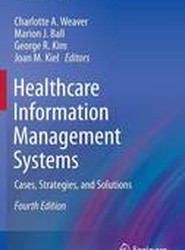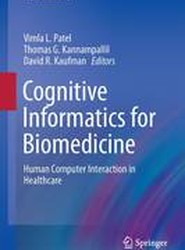(To see other currencies, click on price)
MORE ABOUT THIS BOOK
Main description:
Introduction to Clinical Informatics fills a void in the Computer in Health Care series. With this volume, Patrice Degoulet and Marius Fieschi provide a comprehensive view of medical informatics and carry that concept forward into the realm of clinical informatics. The authors draw upon their experi ences as medical school faculty members in France, where informatics has long been integrated into the curriculum and where the French version of this very book has been used, tested, and revised. In intent and content, this volume stands as the companion volume to Introduction to Nursing Informatics, one of the series' best selling titles. For practitioners and students of medicine, pharmacy, and other health profes sions, Introduction to Clinical Informatics offers an essential understanding how computing can support patient care, clarifying practical uses and critical issues. Today medical schools in the United States are making informatics a part of their curriculum, with required medical informatics blocks at the onset of training serving as the base for problem-based learning throughout the course of study. In an increasingly networked and computerized environ ment, health-care providers are having to alter how they practice. Whether in the office, the clinic, or the hospital, health-care professionals have access to a growing array of capabilities and tools as they deliver care. Learning to use these becomes a top priority, and this volume becomes a valuable resource.
Contents:
1. Systems for Managing Medical Information.- Principles of Computer Operations.- Hardware Architecture.- Encoding Information in a Machine.- The Memory Hierarchy.- Computer Categories.- Central Processing Unit Operations.- Input-Output Peripherals.- Software Architecture.- Operating Systems.- Development Environments and Utilities.- Application Programs.- Communications and Networks.- Network Architecture.- Standards for Exchanging Information.- Integrated System Architectures.- Centralized Systems.- Distributed Systems.- Multimedia Workstations.- Network of Networks.- Exercises.- 2. Medical Software Development.- Computer Project Management.- Waterfall Models.- Spiral Methods and Quick Prototyping.- Conceptual Models.- The Notion of a Model.- Objects and Relationships.- Modeling Intermediate Structures.- Semantic Networks.- Software Development Tools.- Computer-Aided Software Engineering.- Database Management Systems.- Document Management Systems.- Interface Management Systems.- Natural Language Processing Tools.- Specialized Software Components.- Electronic Data Interchange.- Integrating Software Components.- Exercises.- 3. Medical Data and Semiology.- The Nature of Medical Data.- Medical Data Types.- The Variability of Medical Data.- Interpreting Medical Data.- Cognitive Processes.- Interpreting Numbers and Words.- Interpreting Associations.- Quantitative Semiology.- The Diagnostic Value of a Test.- Sensitivity and Specificity of a Sign.- Measuring the Predictive Value of a Sign.- Discussion and Conclusions.- Exercises.- 4. Medical Reasoning and Decision-Making.- Reasoning.- Deduction.- Induction.- Abduction.- Causal Reasoning.- The Steps Involved in Making a Medical Decision.- Identify the Problem.- Structure the Problem.- Choose the Solution.- Uncertainty and Medical Judgment.- Medical Judgment.- Uncertainty and Judgment Bias.- Probability Theory and Decision Analysis.- Comparing Several Diagnostic Hypotheses.- Evaluating the Benefits of Therapy.- Decision Analysis.- Symbolic Reasoning and Expert Systems.- Knowledge Representation.- Using Knowledge.- Learning.- Discussion and Conclusion.- Exercises.- 5. Medical Language and Classification Systems.- Coding and Classifications.- Examples of Classifications.- Clinical Classifications.- The NANDA Classification of Nursing Diagnoses.- Classification of Treatments and Procedures.- Multidomain Classifications.- Discussion and Conclusion.- Exercises.- 6. Documentation Systems and Information Databases.- Technical Infrastructure.- Workstations.- Connecting to Networks.- Archiving and Server Functions.- General Characteristics.- Document Mediation.- The Quality of a Documentation Management System.- Documentation Systems.- Bibliographical Databases.- Medical Information and Knowledge Bases.- Discussion and Conclusion.- Exercises.- 7. Hospital Information Systems.- Analysis of the Information System.- The Various Levels of the Information System.- The Environment of the Information System.- HIS Objectives.- Structural Analysis.- Functional Analysis.- The Components of an HIS.- Administration.- Health-Care Units.- Ancillary Departments.- Strategies and Technical Solutions.- The Vertical Approach: Centralized HIS.- The Horizontal Approach: Departmental Systems.- The Distributed Approach: Distributed and Open Systems.- Required Resources.- Allocating Resources and Estimating Costs.- Human Resources.- Discussion and Conclusion.- Exercises.- 8. Health-Care Networks.- The Health System.- Health-Care Coverage.- Medical Demographics.- Health-Care Networks and Health Information Systems.- The Components of a Health-Care Network.- Telemedicine Tools in Health-Care Networks.- Data Access and Communications.- The Information System for Generalists.- The Key Role of the Generalist in the Health-Care Network.- Computerizing the Doctor's Office.- The Patient's Information System.- Active Participation in Health Care.- Training at Home.- Electronic Messaging.- Discussion and Conclusion.- Exercises.- 9. Managing Patient Records.- Different Views of Patient Records.- Objectives and Expected Benefits.- Modeling Medical Information.- How to Standardize Medical Terminology.- How to Structure Medical Records.- Implementing Computerized Medical Records.- The Software Environment.- Patient Management Systems.- Hardware and Human Constraints.- Discussion and Conclusion.- Exercises.- 10. Physiological Signal Processing.- Importance and Objectives.- Basic Signal Processing Concepts.- Signal Acquisition.- Sampling and Digitizing Signals.- Basic Signal Processing Techniques.- Sample Medical Applications.- Examples of Signal Analysis.- Intensive Care Monitoring.- Integration in Information Systems.- Discussion and Conclusion.- Exercises.- 11. Medical Imaging Systems.- Importance and Objectives.- Image Acquisition Sources.- Digitized Images.- Spatial Coding.- Intensity Coding.- Temporal Coding.- Digitizing Images.- Basic Image Processing Principles.- The Imaging Process.- Image Preprocessing.- Segmentation.- Extracting Parameters.- Image Interpretation.- Sample Medical Applications.- Quantifying the Degree of a Vascular Stenosis.- Identifying Chromosomes.- Computer-Aided Surgical Techniques.- Virtual Reality.- Imaging Management and Communication Systems.- Tele-expertise.- PACS.- Discussion and Conclusion.- Exercises.- 12. Medical Decision Support Systems.- Characteristics of Decision Support Systems.- Types of Support.- Types of Intervention.- Types of Knowledge.- Methodological Basis of Decision Support Systems.- Using Mathematical Models.- Statistical Methods.- Probability-Based Systems.- Artificial Intelligence and Expert Systems.- Neural Networks and Connectionist Systems.- Implementing Decision Support Systems.- The User Interface.- Knowledge Acquisition and Representation.- Evaluating and Validating Systems.- Integrating Decision Support Modules in Information Systems.- Sample Decision Support Systems.- Pharmacokinetics and Assistance in Calculating Dosages.- Assistance in Diagnosing Acute Abdominal Pain.- Diagnoses in Internal Medicine: INTERNIST and QMR.- Assistance in Chemotherapy: ONCOCIN.- Integration in a Hospital Information System. HELP.- Decision Support in Molecular Biology.- Discussion and Conclusion.- Exercises.- 13. Computer-Based Education.- The Need for a Global Pedagogical Approach.- The Role of Computer-Based Education.- Methods and Implementations.- Tutorial Training.- Modeling and Simulation.- On-Site Teaching.- Intelligent CBE Systems.- Discussion and Conclusion.- Exercises.- 14. Analysis and Control of Medical Activity.- Controlling Health-Care Expenses.- Evaluation, Control, and Quality.- Methods and Principles for Analyzing Medical Activity.- A General Model.- Evaluating Costs.- Two Approaches for "Medicalized" Management.- Analyzing Medical Activity in the Hospital.- Resource Indicators.- Activity Indicators.- Production Indicators.- Quality Indicators.- Discussion and Conclusion.- Exercises.- 15. Security and Data Protection.- Identifying the Risks.- Protecting Data Concerning Individuals.- Professional Ethics and Legal Measures.- Measures Concerning Hardware, Software, and Organization.- Discussion and Conclusion.- Exercises.- Appendix A. Review of Probabilities.- Conditional Probabilities.- Baves' Formula.- Rc 'ative Risk and Odds Ratio.- Appendix B. Review of Logic.- Prepositional Logic.- Predicate Logic.- Appendix C. Some Useful References.- Medical Informatics Associations.- In France.- In Europe.- In the United States.- The International Medical Informatics Association.- Principal International Conferences.- Principal Specialized Publications.- Internet Addresses.- General Catalogs and Electronic Libraries.- Informatics in Health Care and Telemedicine, Standards.- Medical Informatics Textbooks.- Data and Knowledge Banks.- Medical guidelines, Evidence-Based Medicine.
PRODUCT DETAILS
Publisher: Springer (Springer-Verlag New York Inc.)
Publication date: October, 2012
Pages: 247
Weight: 421g
Availability: Available
Subcategories: General Issues
From the same series
Christopher G. Chute
Adrian Stavert-Dobson
John T. Finnell
Marion J. Ball
Marion J. Ball
Thomas Wetter
Vimla L. Patel
Naakesh A. Dewan
Chris McCarthy
Kathryn J. Hannah
Stephen Goundrey-Smith
Sajeesh Kumar
William F. Bria
Naakesh A. Dewan
Sajeesh Kumar
Philip R.O. Payne
Stephen Goundrey-Smith
Valerie Powell
J.A. Magnuson
Vimla L. Patel
Morris F. Collen
Gondy Leroy
Sajeesh Kumar
Alain Venot
Eta S. Berner
James Andrews
Bruce R. Schatz
Prakash M. Nadkarni
Naakesh A. Dewan
Joan M. Kiel
Reinhold Haux
Marion J. Ball
Michael K. Bourke
Krzysztof Zielinski
Chris McCarthy
Marion J. Ball
Sajeesh Kumar
Marion J. Ball
Robert M. Kolodner
Kimball I. Maull
Stephen Goundrey-Smith
Erica L. Drazen
Joyce C. Niland
Stephen Goundrey-Smith
Peter L. Elkin
Edward H. Shortliffe
Nancy M. Lorenzi
James Andrews
Valerie Powell
Louis M. Abbey
Morris F. Collen
Lawrence L. Weed
Patricia Flatley Brennan
Gondy Leroy
Sajeesh Kumar
Bruce Schatz
Prakash M. Nadkarni
Christoph U. Lehmann
Reinhold Haux
Marion J. Ball
Marion J. Ball
Rudi van de Velde
Nancy M. Lorenzi
Deborah Lewis
Kenneth Goodman
Eleanor Callahan Hunt
Marion J. Ball
Marion J. Ball
Patrick W. O'Carroll
James G. Anderson
James E. Demetriades
Rajeev K. Bali
Marion J. Ball
Harold P. Lehmann
Susan Houston
Eta S. Berner
Patricia Flatley Brennan
Charles P. Friedman
Reinhold Haux
Naakesh A. Dewan
Ursula Hubner
Nancy M. Lorenzi
Keith Ruskin
Christoph U. Lehmann
William F. Bria
Keith Ruskin
Susan Houston
Ursula Hubner
Patricia Flatley Brennan
Eta S. Berner
Rajeev K. Bali
Harold P. Lehmann
Marion J. Ball
































































































